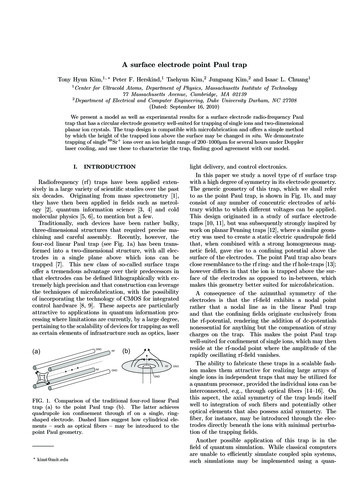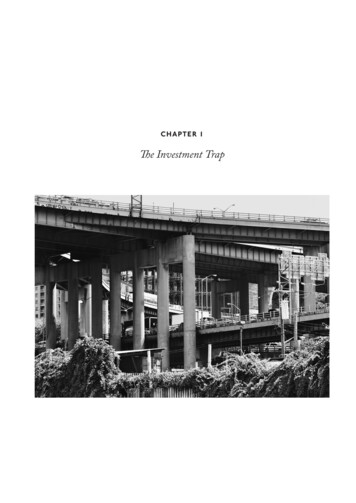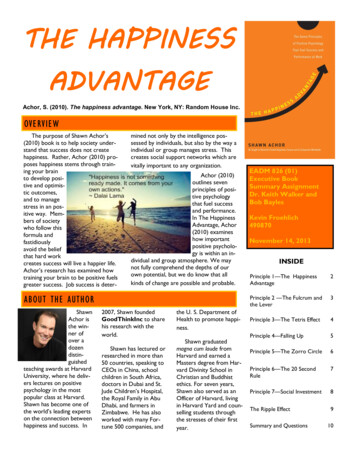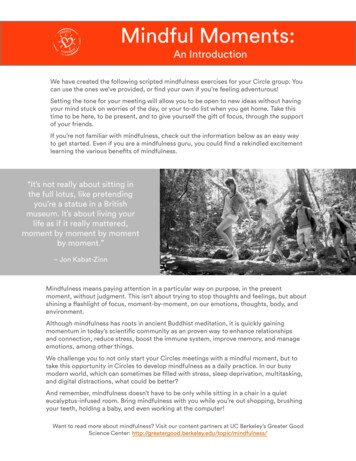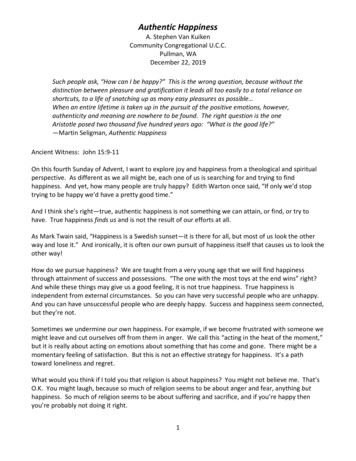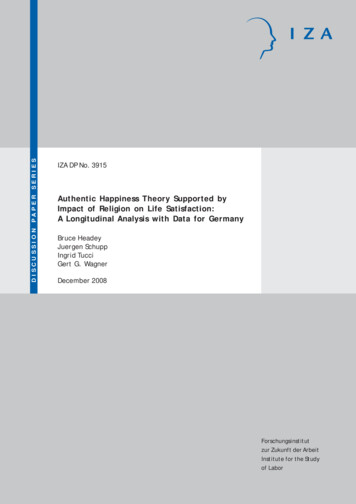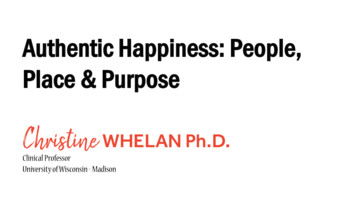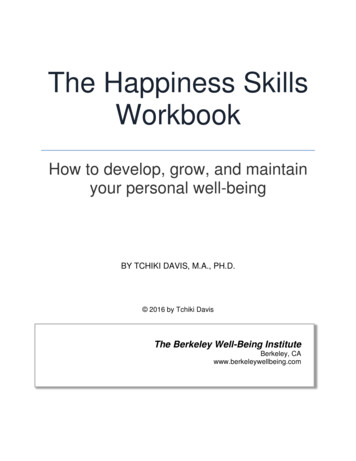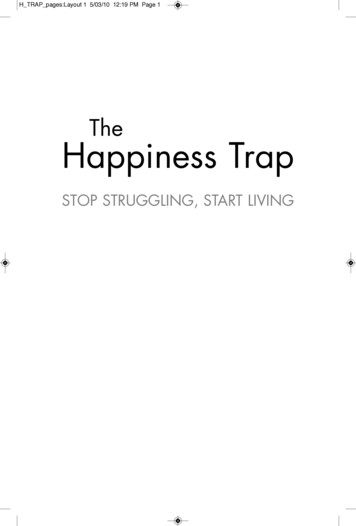
Transcription
H TRAP pages:Layout 1 5/03/10 12:19 PM Page 1TheHappiness TrapSTOP STRUGGLING, START LIVING
H TRAP pages:Layout 1 5/03/10 12:19 PM Page 2Dr Russ Harris has written an easy to read, practical book on how to manage themany challenges life presents us. A great read, with strategies galore.Dr Rick KausmanAuthor of If Not Dieting, Then What?It seems so much easier to find the meaning in life and get on with living afterreading Dr Russ Harris’s book. Full of helpful strategies and common sense ideas,The Happiness Trap is a wonderful journey of reassurance for anyone who istroubled by worrying feelings, nagging anxiety and moods of despair. As apsychologist who works with such people, it is wonderful to be able to recommendthis book. I use the strategies myself and they really do work!Dr Mandy Deeks, Psychologist, The Jean Hailes Foundation for Women’s HealthAuthor of Life Begins at MenopauseDr Russ Harris skillfully leads the reader on a path along which we may pick upand embrace the tools for living a rich, full and authentically meaningful life - a lifewherein real “happiness” truly resides. The Happiness Trap is a book for all –therapists and clients alike – it makes the skills of mindfulness accessible andapplicable to everyday living.Christine Burke, Psychologist BA Dip Ed, M Ed (Counselling Psychology)Happiness is an elusive state. Highly valued, relentlessly perused, rarelyexperienced. Ironically, the harder we try to buy, seize, or closet happiness, the lesslikely we are to be happy. Indeed, even talking about “how we can be happy” oftenleaves us with a sense of dissatisfaction – the happiness trap. This is why Dr RussHarris’s book is so useful. This book is about practical and effective ways tounderstand, to accept, and to embrace the world as it is. Acceptance is thefoundation from which happiness grows. The evidence-based techniques and skillstaught in this book will strengthen your ability to accept, will help you develop thecourage to change the things that can be changed, and will further develop thewisdom to know the difference. I highly recommend this to you.Dr Anthony Grant, Psychologist, Director of Coaching Psychology at Sydneyuniversity, Author of It’s Your Life – What Are You Going To Do With It!This is a highly readable and original book. It goes against much of thecultural mainstream by arguing that directly trying to be happy may actuallymake you miserable. The book offers an alternative roadmap, one that helpsyou avoid emotional detours and guides you towards a life that is rich,full, and meaningful. If you feel like you are not living up to your fullpotential, this is the book for you.Dr. Joseph Ciarrochi, School of Psychology , University of Wollongong
H TRAP pages:Layout 1 5/03/10 12:19 PM Page 3TheHappiness TrapSTOP STRUGGLING, START LIVINGDr Russ Harris
H TRAP pages:Layout 1 5/03/10 12:19 PM Page 4The cases mentioned in this book are all based on real people.However, their names and key distinguishing details have beenchanged to prevent identification.First published 2007Exisle Publishing Limited‘Moonrising’, Narone Creek Road, Wollombi, NSW 2325, AustraliaP.O. Box 60–490, Titirangi, Auckland 0642, New Zealandwww.exislepublishing.comCopyright 2007 in text: Dr Russ HarrisDr Russ Harris asserts the moral right to be identified as the author of this work.All rights reserved. Except for short extracts for the purpose of review, no part of this bookmay be reproduced, stored in a retrieval system or transmitted in any form or by anymeans, whether electronic, mechanical, photocopying, recording or otherwise, withoutprior written permission from the publisher.National Library of Australia Cataloguing-in-Publication Data:Harris, Russell, 1966–.The happiness trap : stop struggling, start living / Dr Russ Harris.ISBN 9780908988907 (pbk.)Includes index.Bibliography1. Happiness. 2. Conduct of life.158.1Designed by Christabella DesignsTypeset in Sabon 11/15Printed in Singapore by KHL Printing Co Pte LtdThis book uses paper sourced under ISO 14001 guidelines from well-managed forests andother controlled sources.20 19 18 17 16 15 14 13 12
H TRAP pages:Layout 1 5/03/10 12:19 PM Page 5DedicationTo my mother and father, for four decades of love, support,inspiration and encouragement. And to my wife Carmel, whoselove, wisdom, and generosity has enriched my life and opened myheart in ways I would never have dreamed possible.5
H TRAP revised pages Layout 1 6/07/10 2:57 PM Page 6CONTENTSForeword8Introduction: I Just Want to Be Happy10PART 1: How You Set The Happiness Trap19Chapter 1: FairytalesChapter 2: Vicious Cycles2031PART 2: Transforming Your Inner pter3: The Six Core Principles of ACT4: The Great Storyteller5: True Blues6: Troubleshooting Defusion7: Look Who’s Talking8: Scary Pictures9: Demons on the Boat10: How Do You Feel?11: The Struggle Switch12: How the Struggle Switch Developed13: Staring Down Demons14: Troubleshooting Expansion15: Urge Surfing16: More Demons17: The Time Machine18: The Dirty Dog19: A Confusing Word20: If You’re Breathing, You’re Alive21: Tell It Like It Is22: The Big Story23: You’re Not Who You Think You 177180189
H TRAP revised pages Layout 1 6/07/10 2:57 PM Page 7PART 3: Creating A Life Worth 24825626724:25:26:27:28:29:30:31:32:33:Follow Your HeartThe Big QuestionTroubleshooting ValuesThe Thousand-mile JourneyFinding FulfilmentA Life of PlentyFacing FEARWillingnessOnward and UpwardA Meaningful LifeWorkshopsFurther 767
H TRAP pages:Layout 1 5/03/10 12:19 PM Page 8ForewordThere is a tremendous irony in happiness. It comes from a rootword meaning ‘by chance’ or ‘an occurrence’, which in a positivesense connotes a sense of newness, wonder, and appreciation ofchance occurrences. The irony is that people not only seek it, theytry to hold on to it — especially to avoid any sense of ‘unhappiness’.Unfortunately, these very control efforts can become heavy,planned, closed, rigid and fixed.Happiness is not just a matter of feeling good. If it were, drugabusers would be the happiest people on the planet. Indeed, feelinggood can be a very unhappy pursuit. It is not by accident that drugusers call their methods of doing so a ‘fix’ — because they arechemically trying to hold something in place. Like a butterflypinned to a table, however, happiness dies unless it is held lightly.Drug abusers are not the only ones. In the name of producing anemotional result we call happiness, most of us tend to engage inbehaviour that is the exact opposite and then feel awful andinadequate with the inevitable result. Until we wise up, we are allgenerally trying to get a ‘fix’ on happiness.This book is based on Acceptance and Commitment Therapy(ACT), which is an empirically supported approach that takes anew and unexpected tack in dealing with the issue of happiness andlife satisfaction. Instead of teaching new techniques to pursuehappiness, ACT teaches ways to undermine struggle, avoidance,and loss of the moment. Russ Harris has very carefully andcreatively presented this approach in an accessible way. In 33 bitesized chapters he systematically explores how we get into the‘Happiness Trap’ and how mindfulness, acceptance, cognitivedefusion, and values can release us from it.8
H TRAP pages:Layout 1 5/03/10 12:19 PM Page 9The joyful message in these pages is that there is no reason tocontinue to wait for life to start. That waiting game can end. Now.Like a lion placed in a paper cage, human beings are generally mosttrapped by the illusions of their own mind. But despite theappearance the cage is not really a barrier that can contain thehuman spirit. There is another way forward, and with this book DrHarris shines a powerful and loving beacon forward into the night,lighting that path.Enjoy the journey. You are in excellent hands.Steven C. HayesOriginator of ACTUniversity of Nevada9FOREWORD
H TRAP pages:Layout 1 5/03/10 12:19 PM Page 10Introduction:I JUST WANT TOBE HAPPY!Just suppose for a moment that almost everything you believedabout finding happiness turned out to be inaccurate, misleading orfalse. And suppose that those very beliefs were making youmiserable. What if your very efforts to find happiness were actuallypreventing you from achieving it? And what if almost everyone youknew turned out to be in the same boat — including all thosepsychologists, psychiatrists and self-help gurus who claim to haveall the answers?I’m not posing these questions just to grab your attention. Thisbook is based on a growing body of scientific research that suggests weare all caught in a powerful psychological trap. We lead our lives ruledby many unhelpful and inaccurate beliefs about happiness — ideaswidely accepted by society because ‘everyone knows they are true’. Onthe surface, these beliefs seem to make good sense — that’s why youencounter them again and again in nearly every self-help book youever read. But these erroneous beliefs are both the cause of and the fuelfor a vicious cycle, in which the more we try to find happiness, themore we suffer. And this psychological trap is so well hidden, we don’teven have a clue that we’re caught and controlled by it.That’s the bad news.The good news is there’s hope. You can learn how to recognisethe ‘happiness trap’ and, more importantly, you can learn how toclimb out of it — and stay out. This book will give you all the skillsand knowledge you need to do it. It’s based on a revolutionary new10
H TRAP pages:Layout 1 5/03/10 12:19 PM Page 11development in human psychology: a powerful model for changeknown as Acceptance and Commitment Therapy (ACT).ACT (pronounced as the word ‘act’) was created in the UnitedStates of America by psychologist Steven Hayes, and was furtherdeveloped by a number of his colleagues, including Kelly Wilsonand Kirk Stroshal. ACT has been astoundingly effective in helpingpatients with a wide range of problems: from depression andanxiety to chronic pain and even drug addiction. For example, inone remarkable study, psychologists Patty Bach and Steven Hayesused ACT with patients suffering from chronic schizophrenia andfound that only four hours of therapy were sufficient to reducehospital readmission rates by half! ACT has also proved highlyeffective for the less dramatic problems that millions of usencounter, such as quitting smoking and reducing stress in theworkplace. Unlike the vast majority of other therapies, ACT has afirm basis in scientific research and, because of this, it is rapidlygrowing in popularity among psychologists all around the world.The aim of ACT is to help you live a rich, full and meaningfullife, while effectively handling the pain that inevitably comes yourway. ACT achieves this through the use of six powerful principles,which are very different from the so-called commonsense strategiessuggested in most self-help books.Is Happiness Normal?In the western world we now have a higher standard of living thanhumans have ever known before. We have better medical treatment,more and better food, better housing conditions, better sanitation,more money, more welfare services and more access to education,justice, travel, entertainment and career opportunities. Indeed,today’s middle class lives better than did the royalty of not so longago, and yet, human misery is everywhere.The psychology and personal development sections of bookstores aregrowing at a rate never seen before, and the bookshelves are groaningunder the strain. The titles cover depression, anxiety, anorexia nervosa,overeating, anger management, divorce, relationship problems, sexualproblems, drug addictions, alcoholism, low self-esteem, loneliness, grief,11I JUST WANT TO BE HAPPY
H TRAP pages:Layout 1 5/03/10 12:19 PM Page 12gambling — if you can name it, there’s a book on it. Meanwhile, onthe television and radio, and in magazines and newspapers, the‘experts’ bombard us daily with advice on how to improve our lives.This is why the numbers of psychologists, psychiatrists, marriageand family counsellors, social workers and ‘life coaches’ areincreasing with every year. And yet — now, think about this — withall this help and advice and worldly wisdom, human misery is notdiminishing but growing by leaps and bounds! Isn’t there somethingwrong with this picture?The statistics are staggering: In any given year almost 30 per centof the adult population will suffer from a recognised psychiatricdisorder. The World Health Organization estimates that depressionis currently the fourth biggest, costliest and most debilitating diseasein the world, and by the year 2020 it will be the second biggest. Inany given week, one-tenth of the adult population is suffering fromclinical depression, and one in five people will suffer from it at somepoint in their lifetime. Furthermore, one in four adults, at somestage in their life, will suffer from drug or alcohol addiction, whichis why there are now over twenty million alcoholics in the UnitedStates of America alone!But more startling and more sobering than all those statistics isthat almost one in two people will go through a stage in life whenthey seriously consider suicide and will struggle with it for a periodof two weeks or more. Scarier still, one in ten people will at somepoint actually attempt to kill themselves.Think about those numbers for a moment. Think of the peoplein your life: your friends, family and co-workers. Consider whatthose figures imply: that of all the people you know, almost half ofthem will at some point be so overwhelmed by misery that theyseriously contemplate suicide. And one in ten will attempt it! In thepast two centuries we have doubled the span of the average humanlife. But have we doubled the richness, the enjoyment, the fulfilmentof that life? These statistics give us the answer, loud and clear:happiness is not normal!12
H TRAP pages:Layout 1 5/03/10 12:19 PM Page 13Why Is It So Difficult To Be Happy?To answer this question, we need to take a journey back in time.The modern human mind, with its amazing ability to analyse, plan,create and communicate, has largely evolved over the last hundredthousand years, since our species, Homo sapiens, first appeared onthe planet. But our minds did not evolve to make us feel good, sowe could tell great jokes, write sonnets and say ‘I love you’. Ourminds evolved to help us survive in a world fraught with danger.Imagine that you’re an early human hunter–gatherer. What are youressential needs in order to survive and reproduce?There are four of them: food, water, shelter and sex, but none ofthese things mean much if you’re dead. So the number one priorityof the primitive human mind was to look out for anything thatmight harm you and avoid it! In essence, the primitive mind was a‘Don’t get killed’ device, and it proved enormously useful. Thebetter our ancestors became at anticipating and avoiding danger, thelonger they lived and the more children they had.With each generation the human mind became increasinglyskilled at predicting and avoiding danger. And now, after a hundredthousand years of evolution, the modern mind is still constantly onthe lookout for trouble. It assesses and judges almost everything weencounter: Is this good or bad? Safe or dangerous? Harmful orhelpful? These days, though, it’s not sabre-toothed cats or 200kilogram wolves that our mind warns us about. Instead it’s losingour job, being rejected, getting a speeding ticket, not being able topay the bills, embarrassing ourselves in public, upsetting our lovedones, getting cancer, or any of a million and one other commonworries. As a result we spend a lot of time worrying about thingsthat, more often than not, never happen.Another essential for the survival of any early human is to belongto a group. If your clan boots you out, it won’t be long before thewolves find you. So how does the mind protect you from rejectionby the group? By comparing you with other members of the clan:Am I fitting in? Am I doing the right thing? Am I contributingenough? Am I as good as the others? Am I doing anything thatmight get me rejected?13I JUST WANT TO BE HAPPY
H TRAP pages:Layout 1 5/03/10 12:19 PM Page 14Sound familiar? Our modern-day minds are continually warningus of rejection and comparing us against the rest of society. Nowonder we spend so much energy worrying whether people will likeus! No wonder we’re always looking for ways to improve ourselvesor putting ourselves down because we don’t ‘measure up’. Ahundred thousand years ago we had only the few members of ourimmediate clan to compare ourselves with. But these days we canopen any newspaper or magazine, switch on any television, tune into any radio, and instantly find a whole host of people who aresmarter, richer, taller, slimmer, sexier, stronger, more powerful, morefamous, more successful, or more admired than we are. What’s thefastest way to make a teenage girl depressed? Show her a fashionmagazine. When she compares herself to all those air-brushed,collagen-enhanced, digitally altered supermodels, she is guaranteedto feel inferior or downright unattractive. And the rest of us are notthat different. Thanks to evolution, our minds are now sosophisticated they can even dream up a fantasy of the person we’dlike to be — and then compare our ‘real’ self to that impossiblestandard. What chance have we got? We will always end up feelingnot good enough!Now, for any Stone Age person with ambition, the general rulefor success is: the more, the better. The more sophisticated yourweapons (and the more of them you have), the more food you cankill. The more plentiful your food stores, the better your chances arefor living through times of scarcity. The more substantial yourshelter, the safer you are from weather and wild animals. The morechildren you have, the better the chance that some of them willsurvive into adulthood. No surprise then, that our modern mindcontinually looks for more: more money, more status, more love,more job satisfaction, a newer car, a younger-looking body, ayounger-looking partner, a bigger house. And if we succeed, if weactually get more money or a newer car or a better job, then we’resatisfied — for a while. But sooner or later (and usually sooner), weend up wanting more.Thus, evolution has shaped our minds so that we are almostinevitably destined to suffer psychologically: to compare, evaluate14
H TRAP pages:Layout 1 5/03/10 12:19 PM Page 15and criticise ourselves; to focus on what we’re lacking; to bedissatisfied with what we have; and to imagine all sorts offrightening scenarios, most of which will never happen. No wonderhumans find it hard to be happy!What Exactly Is ‘Happiness’?We all want it. We all crave it. We all strive for it. Even the DalaiLama has said: ‘The very purpose of life is to seek happiness.’ Butwhat exactly is this elusive thing we are looking for?The word ‘happiness’ has two very different meanings. Usually itrefers to a feeling: a sense of pleasure, gladness or gratification. We allenjoy happy feelings, so it’s no surprise that we chase them. However,like all our other feelings, feelings of happiness don’t last. No matterhow hard we try to hold on to them, they slip away every time. Andas we shall see, a life spent in pursuit of those feelings is, in the main,unsatisfying. In fact, the harder we pursue pleasurable feelings, themore we are likely to suffer from anxiety and depression.The other meaning of happiness is ‘a rich, full and meaningfullife’. When we take action on the things that truly matter deep inour hearts, when we move in directions that we consider valuableand worthy, when we clarify what we stand for in life and actaccordingly, then our lives become rich and full and meaningful,and we experience a powerful sense of vitality. This is not somefleeting feeling — it is a profound sense of a life well lived. Andalthough such a life will undoubtedly give us many pleasurablefeelings, it will also give us uncomfortable ones, such as sadness,fear and anger. This is only to be expected. If we live a full life, wewill feel the full range of human emotions.In this book, as you’ve probably guessed by now, we are far moreinterested in the second meaning of happiness than in the first. Ofcourse, happy feelings are quite pleasant, and we should certainlymake the most of them when they present themselves. But if we tryto have them all the time, we are doomed to failure.The reality is, life involves pain. There’s no getting away from it.As human beings we are all faced with the fact that sooner or laterwe will grow infirm, get sick and die. Sooner or later we all will lose15I JUST WANT TO BE HAPPY
H TRAP pages:Layout 1 5/03/10 12:19 PM Page 16valued relationships through rejection, separation or death. Sooneror later we all will come face-to-face with a crisis, disappointmentand failure. This means that in one form or another, we are all goingto experience painful thoughts and feelings.The good news is that, although we can’t avoid such pain, wecan learn to handle it much better — to make room for it, rise aboveit and create a life worth living. This book will show you how to doso. There are three parts to this process.In Part 1 you will learn how you create and get stuck in thehappiness trap. This is an essential first step, so please don’t skip it— you can’t escape the trap if you don’t know how it works.In Part 2, rather than trying to avoid or eliminate painfulthoughts and feelings, you will learn how to fundamentallytransform your relationship with them. You will learn how toexperience painful thoughts and feelings in a new way that willlessen their impact, drain away their power, and dramaticallydecrease their influence over your life.Finally, in Part 3, instead of chasing happy thoughts and feelings,you will focus on creating a rich and meaningful life. This will giverise to a sense of vitality and fulfilment that is both deeply satisfyingand long lasting.The Journey AheadThis book is like a trip through a foreign country: much will seemstrange and new. Other things will seem familiar yet somehowsubtly different. At times you may feel challenged or confronted, atother times excited or amused. Take your time on this journey.Instead of rushing ahead, savour it fully. Stop when you findsomething stimulating or unusual. Explore it in depth and learn asmuch as you can. To create a life worth living is a majorundertaking, so please take the time to appreciate it.16
H TRAP pages:Layout 1 5/03/10 12:19 PM Page 17
H TRAP pages:Layout 1 5/03/10 12:19 PM Page 19PART1How You Set TheHappiness Trap
H TRAP pages:Layout 1 5/03/10 12:19 PM Page 20Chapter 1:FAIRYTALESWhat’s the last line of every fairytale? You got it: ‘ and they livedhappily every after.’ And it’s not just fairytales that have happyendings. How about Hollywood movies? Don’t they nearly alwayshave some sort of feel-good ending where good triumphs over evil,love conquers all, and the hero defeats the bad guy? And doesn’t thesame hold true for most popular novels and television programs? Welove happy endings because society tells us that’s how life should be:all joy and fun, all peace and contentment, living happily ever after.But does that sound realistic? Does it fit in with your experience oflife? This is one of four major myths that make up the basic blueprintfor the happiness trap. Let’s take a look at these myths, one by one.Myth No. 1: Happiness Is The Natural State For AllHuman BeingsOur culture insists that humans are naturally happy. But thestatistics quoted in the introduction clearly disprove this.Remember, one in ten adults will attempt suicide, and one in fivewill suffer from depression. What’s more, the statistical probabilitythat you will suffer from a psychiatric disorder at some stage in yourlife is almost 30 per cent! Not exactly great odds, are they?And when you add in all the misery caused by problems that arenot classified as psychiatric disorders — loneliness, divorce, sexualdifficulties, work stress, midlife crisis, relationship issues, domesticviolence, social isolation, bullying, prejudice, low self-esteem, chronicanger and lack of meaning or purpose in life — you start to get someidea of just how rare true happiness really is. Unfortunately, manypeople walk around with the belief that everyone else is happyHOW YOU SET THE HAPPINESS TRAP20
H TRAP pages:Layout 1 5/03/10 12:19 PM Page 21except for them. And — you guessed it — this belief creates evenmore unhappiness.Myth No. 2: If You’re Not Happy, You’re DefectiveFollowing logically from Myth 1, western society assumes thatmental suffering is abnormal. It is seen as a weakness or illness, aproduct of a mind that is somehow faulty or defective. This meansthat when we do inevitably experience painful thoughts andfeelings, we often criticise ourselves for being weak or stupid.Health professionals contribute to this process by readily slappingon labels such as, ‘You’re depressed’, and these labels merelyconfirm how defective we are.Acceptance and Commitment Therapy is based on a dramaticallydifferent assumption. ACT proposes that the normal thinkingprocesses of a healthy human mind will naturally lead topsychological suffering. You’re not defective — your mind’s justdoing its job; the thing it evolved to do. Fortunately, ACT can teachyou how to adapt to this in such a way that your life will bepowerfully transformed.Myth No. 3: To Create A Better Life, We Must GetRid Of Negative FeelingsWe live in a feel-good society, a culture thoroughly obsessed withfinding happiness. And what does that society tell us to do? Toeliminate ‘negative’ feelings and accumulate ‘positive’ ones in theirplace. It’s a nice theory and on the surface it seems to make sense.After all, who wants to have unpleasant feelings? But here’s thecatch: the things we generally value most in life bring with them awhole range of feelings, both pleasant and unpleasant. Forexample, in an intimate long-term relationship, although you willexperience wonderful feelings such as love and joy, you will alsoinevitably experience disappointment and frustration. There is nosuch thing as the perfect partner and sooner or later conflicts ofinterest will happen.The same holds true for just about every meaningful project weembark on. Although they often bring feelings of excitement and21FAIRYTALES
H TRAP pages:Layout 1 5/03/10 12:19 PM Page 22enthusiasm, they also generally bring stress, fear and anxiety. So ifyou believe Myth 3, you’re in big trouble, because it’s pretty wellimpossible to create a better life if you’re not prepared to have someuncomfortable feelings. However, in Part 2 of this book, you willlearn how to handle such feelings altogether differently, toexperience them in such a way that they bother you a whole lot less.Myth No. 4: You Should Be Able To Control WhatYou Think And FeelThe fact is, we have much less control over our thoughts andfeelings than we would like. It’s not that we have no control; it’s justthat we have much less than the ‘experts’ would have us believe.However, we do have a huge amount of control over our actions.And it’s through taking action that we create a rich, full andmeaningful life. (That’s why we say ACT as the word ‘act’, ratherthan as the initials A.C.T.)The overwhelming majority of self-help programs subscribe toMyth 4. For example, many approaches teach you to identifynegative thoughts and replace them with more positive ones. Otherapproaches encourage the repetition of positive affirmations suchas, ‘Everything that happens is for my highest good and greatestjoy’, or ‘I am strong, able and capable at all times’. Still otherapproaches encourage you to visualise what you want, to vividlyimagine yourself the way you want to be, living the life you dreamof. The basic theme of all these approaches is this: if you challengeyour negative thoughts or images and, instead, repeatedly fill yourhead with positive thoughts and images, you will find happiness. Ifonly life were that simple!I’m willing to bet that you’ve already tried countless times to thinkmore positively about things and yet those negative thoughts keepcoming back again and again. As we saw in the last chapter, ourminds have evolved over a hundred thousand years to think the waythey do, so it’s not likely that a few positive thoughts or affirmationswill change them all that much! It’s not that these techniques have noeffect; they can often make you feel better temporarily. But they willnot get rid of negative thoughts over the long term.HOW YOU SET THE HAPPINESS TRAP22
H TRAP pages:Layout 1 5/03/10 12:19 PM Page 23The same holds true for ‘negative’ feelings such as anger, fear,sadness, insecurity and guilt. There are multitudes of psychologicalstrategies to ‘get rid of’ such feelings. But you’ve undoubtedlydiscovered that even if they go away, after a while they’re back. Andthen they go away again. And then they come back again. And soon and so on. The likelihood is, if you’re like most other humans onthe planet, you’ve already spent a lot of time and effort trying tohave ‘good’ feelings instead of ‘bad’ ones — and you’ve probablyfound that as long as you’re not too distressed, you can, to somedegree, pull it off. But you’ve probably also discovered that as yourlevel of distress increases, your ability to control your feelingsprogressively lessens. Sadly, Myth 4 is so widely believed that wetend to feel inadequate when our attempts to control our thoughtsand feelings fail.These four powerful myths provide the basic blueprint for thehappiness trap. They set us up for a struggle we can never win: thestruggle against our own human nature
It seems so much easier to find the meaning in life and get on with living after reading Dr Russ Harris’s book. Full of helpful strategies and common sense ideas, The Happiness Trap is a wonderful journey of reassurance for anyone who is troubled by worrying


